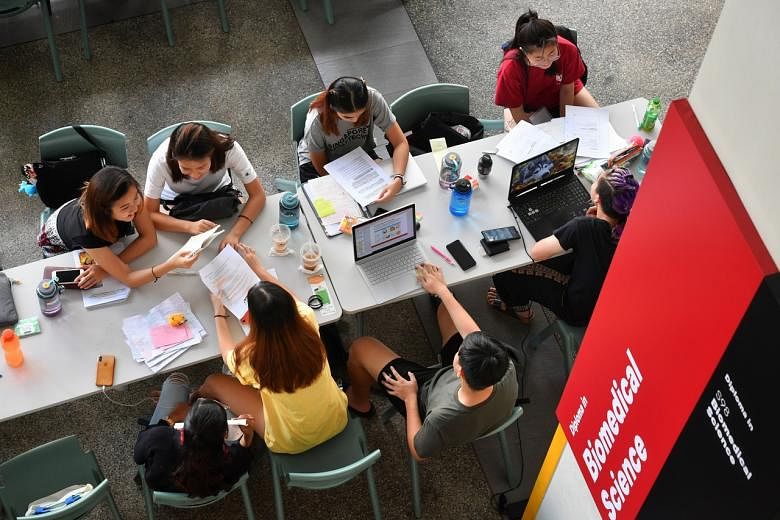SINGAPORE - With a better understanding of their study and career aspirations and encouraged by the increasing number of polytechnic graduates making it to the local universities, more O-level school leavers are taking the polytechnic route.
The Ministry of Education (MOE) said that of the 20,300 candidates posted to a post-secondary educational institution last year via the Joint Admissions Exercise, 52 per cent were posted to the five polytechnics here. This is a record in recent years.
Another 38 per cent were given places in the junior colleges (JCs) and Millennia Institute, a figure that did not account for those enrolled in the six-year Integrated Programme, where students skip the O levels and go straight to JC1.
Another 10 per cent were posted to the Institute of Technical Education.
The MOE said around 45 per cent of the O-level students admitted to the polytechnics last year had qualified for JC, which requires better results for entry, compared with 40 per cent in 2014.
To qualify for a JC place, a student's L1R5 score - based on English and five relevant subjects - must not exceed 20 points.
Polytechnics require grades for English and four other subjects to not exceed 26 points, although for the more popular courses, successful applicants need to score under 12 points.
Temasek Polytechnic (TP) biomedical engineering student Jove Lee, 18, realised while in secondary school that he prefers hands-on learning.
The student, who had done well enough in his O levels to enter a top JC, said: "I hope to go on to do research in biomedicine, but I chose to go to a poly because I learn so much better when I get to practise what I learn."
TP principal Peter Lam noted that in recent years, the polytechnic has seen an increased proportion of JC-eligible students enrolling in its diploma programmes.
He said: "I see this as the direct result of MOE's education and career guidance programme, which has successfully provided students with comprehensive information regarding their education and career options."
Schools have stepped up education and career counselling so that those going for further education will be able to make more informed decisions.
Added Mr Lam: "There is now a greater awareness of poly education and the many pathways beyond the diploma apart from work, such as further studies in the universities and work-study programmes."
Students and parents interviewed said the poly route has also become more appealing, with the Government making more places available to those who want to upgrade their diploma to a degree.
When the Government announced the expansion of university places in 2012, only 20 per cent of poly graduates made it to the local universities. By 2019, 30 per cent of poly graduates made it to one of the six local universities.
Most of the new university places created, including at the Singapore University of Social Sciences and Singapore Institute of Technology, went to poly diploma holders.
Housewife R. Mallika, 46, and her husband, who both hold degrees, said their entrepreneurial 17-year-old son, who is collecting his O-level results on Monday (Jan 11), wants to study banking and finance in Ngee Ann Polytechnic.
"We both started off preferring the JCs, but now, looking at the increasing number of poly grads making it to local unis and the top courses they are getting into, we have changed our minds," said Mrs Mallika.


